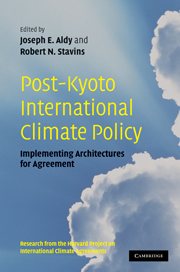Book contents
- Frontmatter
- Contents
- Harvard Environmental Economics Program, International Advisory Board
- Harvard Project on International Climate Agreements, Faculty Steering Committee
- Harvard Project on International Climate Agreements, Project Management
- List of figures
- List of tables
- List of contributors
- Foreword
- 1 Introduction
- Part I Alternative international policy architectures
- 2 An elaborated proposal for a global climate policy architecture: specific formulas and emission targets for all countries in all decades
- 3 The EU emission trading scheme: a prototype global system?
- 4 Linkage of tradable permit systems in international climate policy architecture
- 5 The case for charges on greenhouse gas emissions
- 6 Towards a global compact for managing climate change
- 7 Sectoral approaches to a post-Kyoto international climate policy framework
- 8 A portfolio system of climate treaties
- Part II Negotiation, assessment, and compliance
- Part III The role and means of technology transfer
- Part IV Global climate policy and international trade
- Part V Economic development, adaptation, and deforestation
- Part VI Modeling impacts of alternative allocations of responsibility
- Part VII Synthesis and conclusion
- Appendix A Selected List of Individuals Consulted, Harvard Project on International Climate Agreements
- Appendix B Workshops and Conferences, Harvard Project on International Climate Agreements
- Glossary and Abbreviations
- Index
6 - Towards a global compact for managing climate change
Published online by Cambridge University Press: 05 June 2012
- Frontmatter
- Contents
- Harvard Environmental Economics Program, International Advisory Board
- Harvard Project on International Climate Agreements, Faculty Steering Committee
- Harvard Project on International Climate Agreements, Project Management
- List of figures
- List of tables
- List of contributors
- Foreword
- 1 Introduction
- Part I Alternative international policy architectures
- 2 An elaborated proposal for a global climate policy architecture: specific formulas and emission targets for all countries in all decades
- 3 The EU emission trading scheme: a prototype global system?
- 4 Linkage of tradable permit systems in international climate policy architecture
- 5 The case for charges on greenhouse gas emissions
- 6 Towards a global compact for managing climate change
- 7 Sectoral approaches to a post-Kyoto international climate policy framework
- 8 A portfolio system of climate treaties
- Part II Negotiation, assessment, and compliance
- Part III The role and means of technology transfer
- Part IV Global climate policy and international trade
- Part V Economic development, adaptation, and deforestation
- Part VI Modeling impacts of alternative allocations of responsibility
- Part VII Synthesis and conclusion
- Appendix A Selected List of Individuals Consulted, Harvard Project on International Climate Agreements
- Appendix B Workshops and Conferences, Harvard Project on International Climate Agreements
- Glossary and Abbreviations
- Index
Summary
The year 2007 witnessed a major surge in interest in controlling the damage that can be done to the global economy due to the accumulation of greenhouse gases (GHGs) in the atmosphere. The Stern Review (Stern 2006) published in October 2006 and publicized in 2007 drew attention to the seriousness of the economic consequences potentially associated with a continuation of present trends in human-induced climate change. In an in-depth cost-benefit analysis (subject to the usual caveats for such analyses), Stern demonstrated that about 1 percent of Gross Domestic Product (GDP) invested in controlling GHG emissions can save an annuitized loss on a broad measure of consumption (that includes nonmarket goods and services) equivalent to 5–20 percent of GDP by mitigating the negative impacts of climate change. In February 2007, the latest assessment report of the Intergovernmental Panel on Climate Change (IPCC 2007a) articulated a growing consensus among climate scientists about the devastating effects of human-induced climate change, particularly for low-income regions and low-income people of the world. Al Gore, the former Vice-President of the United States, in his powerful documentary, An Inconvenient Truth, which won two Academy Awards, demonstrated in a graphic manner the high costs of climate change for the world, including developed countries. Since then, and also under the leadership of Al Gore, a series of Live Earth Concerts around the world have continued raising global consciousness about the dangers of climate change.
- Type
- Chapter
- Information
- Post-Kyoto International Climate PolicyImplementing Architectures for Agreement, pp. 179 - 200Publisher: Cambridge University PressPrint publication year: 2009
- 1
- Cited by

